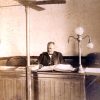calsfoundation@cals.org
Sex Work
aka: Prostitution
Sex work in Arkansas’s territorial and early statehood days is poorly documented. However, “houses of ill-fame” existed in Little Rock (Pulaski County) at least as early as 1836. In March 1836, the Arkansas Gazette reprinted a report from the Vicksburg Register wherein the city of Vicksburg, Mississippi, claimed that it did not have a single gambling establishment or house of ill fame within its jurisdiction. The Arkansas Gazette writer lamented that the same could not be said for Little Rock.
Arkansas’s capital city was also among the earliest of Arkansas’s towns and cities to begin passing ordinances to curtail the commercialization of sex. In 1848, the Little Rock City Council passed an ordinance stating that “all bawdy houses, or houses where abandoned women are kept for public hire…shall be and are hereby declared nuisances, and the City Police is authorized to remove such nuisances.”
After the end of the Civil War, sex work in Little Rock increased substantially. An 1866 ordinance passed by the Little Rock City Council outlined offenses against public morals and stated that keeping a bawdy house was a misdemeanor. Still, by 1870, women such as Kate Marsh and Kate Merrick were making names for themselves in Little Rock as owners of “places of resort.”
Arkansas was one of a few states to delegate the regulation of brothels to municipal entities. In March 1875, an Arkansas act describing the incorporation, regulation, and management of municipal corporations granted municipalities the right to “regulate or suppress bawdy houses, disorderly, assignation and houses of ill fame.” This was later published in 1884 in Mansfield Digest. Arkansas cities and towns subsequently began passing various ordinances concerning the presence of bordellos. In 1888, the Forrest City (St. Francis County) town council passed an ordinance “to prohibit lewdness” and to outlaw the presence of bordellos within the city limits. Prostitution was deemed unlawful in Fayetteville (Washington County) via an 1889 ordinance, and the town council of Nashville (Howard County) ordered in 1898 that being found loitering near street corners or known bawdy houses could result in one being charged with vagrancy.
Despite the ordinances passed by city and town councils across the state in an attempt to regulate commercial sex work, there was relatively little done to actually enforce them. It was common practice for authorities to bring sex workers before the courts to charge them a routine fee, after which they were generally allowed to carry out their business as usual.
At the beginning of the twentieth century, the country as a whole was reckoning with various ideas of morality and the regulation of vice. Many began to question the previous policies of tolerance surrounding sex work. Multiple cities throughout the country attempted to regulate vice through the creation of “segregated districts,” wherein brothel owners and sex workers were allowed to conduct their usual business, but only within specific parameters of the town.
Fort Smith (Sebastian County) was one city that formally implemented the segregation of vice. In 1907, the city council of Fort Smith passed an ordinance that legalized prostitution within a select few blocks of the city. The ordinance also required brothel owners to receive licenses to operate their business and pay a monthly fee to the city to maintain that license. Sex workers were also required to undergo medical inspections twice a month. Miss Laura’s Social Club was one of the brothels within the segregated district and is the only one that remains standing. By 2025, it was operating as Miss Laura’s Brothel Museum after serving for more than thirty years as a visitor center for Fort Smith.
The ordinance in Fort Smith was repealed in the 1920s as a result of growing anti–sex work sentiments, though the women in the district were sometimes subjected to periodic police raids even while the sex work was still legal within the district. After the repeal of the ordinance, sex work continued to be a fairly lucrative enterprise, though city officials conducted raids and implemented fines for those who violated the new city law. Still, Miss Laura’s remained open under the ownership of Bertha Dean until her death in 1948.
The brothels of Little Rock remained open until 1913, when Mayor Charles Edward Taylor created the Little Rock Commission on Vice to investigate the “social evil problem.” The commission, which was chaired by John Ellis Martineau, recommended that all brothels in Little Rock be closed by no later than August 25, 1913. This did not put an end to the act of transactional sex. Instead, the practice transitioned to other, somewhat less conspicuous locations, such as hotels.
Concerns regarding sex work and the subsequent spread of venereal disease only became more prevalent at the onset of World War I. Campaigns to keep soldiers “fit to fight” emerged, along with public health services and organizations. Although Little Rock’s red light district had been formally closed before the United States entered the war, Hot Springs (Garland County) had a reputation for legalized sex work since the late nineteenth century. This became a concern to Little Rock officials, as soldiers at Camp Pike in Little Rock had some of the highest syphilis infection rates in the country. Believing that Camp Pike soldiers were partaking in the vice that was available in Hot Springs, military commanders ordered Hot Springs to close its brothels for the duration of the war, or else they would prohibit soldiers from spending their leisure time—and money—in Hot Springs.
Protecting soldiers from the rapid spread of venereal disease continued to be a top priority into World War II. By 1941, city officials across the state were grappling with ways to curb the increasing spread of venereal disease, which was often blamed on sex workers. The number of adult women who turned to sex work increased during the war, but the primary concern of Arkansas authorities was the rising number of under-age girls who also turned to sex work in the face of low wages. Arkansas lacked laws surrounding under-age prostitution, and, in an effort to control infection rates, military officials threatened to implement restrictions on soldiers traveling into nearby cities unless city officials enforced curfews for minors.
As brothels had largely been done away with across the state in previous decades, sex workers instead began operating in other locations, primarily hotels and massage parlors. In order to determine the state of sex work across the country, the American Social Health Association (ASHA) conducted “prostitution surveys” in various states. Between 1956 and 1967, the ASHA conducted thirty-four prostitution surveys in several Arkansas cities, including Little Rock, Fort Smith, Hot Springs, North Little Rock (Pulaski County), Texarkana (Miller County), West Memphis (Crittenden County), and Blytheville (Mississippi County).
The ASHA reports revealed that sex workers were “easily accessible” in both Little Rock and Fort Smith, and that they often used a middle-man, such as a taxi driver and hotel bellhop, as a go-between for securing clients. Surveys from 1957 and 1959 also indicated that there was “a considerable amount of prostitution” in Hot Springs as well, though this was attributed to the fact that Hot Springs was being run as an “open city,” where sex work and gambling were openly practiced. After a prostitution survey in Little Rock in 1967, ASHA staff recommended that Little Rock officials adopt ordinances that would require those applying for jobs as hotel bellhops to undergo identification and background checks, as well as requiring male massage therapists to care for male customers and female massage therapists to care for female clients, though Little Rock did not heed the recommendations.
Sex work is illegal in Arkansas in the twenty-first century, as well as in forty-eight other states in the United States. Arkansas Criminal Code of 1987, Title 5, chapter 70 outlines the definitions and laws regarding prostitution in the state of Arkansas. By 2025, many had begun calling for the de-stigmatization and decriminalization of sex work. Recent scholarly discourse encourages people to be mindful of the language used when talking about sex workers, as historical terms such as “whore,” “lewd woman,” “nymph du pave,” and “prostitute” are believed to re-enforce degrading ideas about sex workers and denies them humanity.
For additional information:
Boulden, Ben. “The 1907 Ordinance.” Fort Smith Historical Society (accessed May 23, 2025).
Bowen, Elliot. Seeking Sexual Health: Diagnosing and Treating Syphilis in Hot Springs, Arkansas, 1890–1940. Baltimore: Johns Hopkins University Press, 2020.
Dillard, Tom. “Brothels of Little Rock.” Arkansas Democrat-Gazette, September 8, 2019, p. 2H.
“Legal and Protective Measures. Surveys. Prostitution Survey Summaries A-K. (Box 105, Folder 04).” University of Minnesota Libraries, Social Welfare History Archives. https://umedia.lib.umn.edu/item/p16022coll223:143916 (accessed May 23, 2025).
Smith, C. Calvin. “Diluting an Institution: The Social Impact of World War II on the Arkansas Family.” Arkansas Historical Quarterly 39 (Spring 1980): 21–34.
Carlie Cowgill
University of Arkansas at Little Rock






Comments
No comments on this entry yet.